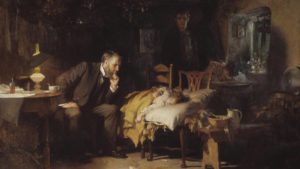This article was orginally published in The Canberra Times on 10th November 2021
By Dr Robert Norton, clinical microbiologist and fellow at the Royal College of Pathologists of Australasia.
Pathology is to immunisation what Dr Watson was to Sherlock Holmes: the observational driving force that allows genius to solve the seemingly insoluble.
We should be in awe of vaccines; they’ve unlocked the great COVID deadlock and handed the world hope for the future. But we must remember the important detective work carried out in pathology labs to support the development of what has become one of the great symbols of human endeavour in modern times. Together, pathology labs and vaccines have risen to each challenge posed by infectious disease throughout history.
Forgive my imperfect analogy, but the Victorian era when Sir Arthur Conan Doyle was penning his great literary works seems like a good place to begin a story examining the impact of vaccines.
It was a brutal period for disease, characterised by a stark relationship between infection and death, but it was also a turning point in the development of vaccines.
The pre-vaccine era

The art, literature and news of the time made reference to grim outcomes. In his 1891 painting The Doctor, painter Luke Fildes depicted the death of his first son, Philip, of typhoid. The image of the doctor at his son’s side during the ordeal left a lasting memory of professional devotion. These days we tend to forget how many children, in particular, were lost to vaccine preventable diseases like Typhoid.
Smallpox
No discussion on vaccination can occur without mention of smallpox, a disease estimated to have been responsible for the deaths of 300 million people in the 20th century alone.
While Edward Jenner in the 18th century is credited with the development of vaccination – using the related cowpox to produce immunity against smallpox – its origins go back much further. The practice of inoculating people with the fluid from smallpox vesicles possibly originated in China in the 1500s, before spreading to the Middle East.
It was the wife of the British ambassador to Turkey, Lady Mary Wortley Montague, who introduced the concept of vaccination against this terrible disease to Western medicine. A trailblazer of the time, she had her own children vaccinated in Turkey using this method, despite the risk of them acquiring smallpox. She then popularised this approach on her return to England, despite resistance from the medical establishment.
Rabies
Once a universally fatal disease, rabies still kills an estimated 55,000 people worldwide each year today. Infection occurs from the bite of a variety of animals, including dogs and bats, infected by the rabies virus, which is related to the Australian bat lyssavirus.
French microbiologist Louis Pasteur produced the first vaccine for rabies by growing the virus in rabbits, and then weakening it by drying the affected nerve tissue.
The vaccine had been tested in 50 dogs before its first human trial on nine-year-old Joseph Meister in 1885, after he had been bitten by a rabid dog. Over 11 days, Meister received 13 inoculations and returned to good health three months later. It was a pivotal moment that laid the foundations for the vaccines of the future.
Tuberculosis
The identification of the causative agent of Tuberculosis (TB) by Robert Koch was a major event for a disease that had been named “The captain of all these men of death”. The causative organism now known as Mycobacterium tuberculosis was identified by Koch in 1882.
Albert Calmette, a French physician and bacteriologist, and his assistant and later colleague, Camille Guérin, created the first vaccine for TB by subculturing a less virulent strain. It took 13 years for the French duo to produce a weakened strain, now known as the BCG strain after the researchers, safe enough to immunise humans for the first time in 1921.
TB still kills around 2 million people worldwide each year, a number that would be much greater had it not been for the BCG vaccine. At the start of the 20th century, it was the leading cause of death in Australia.
Q fever
Closer to home, it was through the astute clinical assessment on a group of abattoir workers in Brisbane that pathologist Dr Ted Derrick was able to identify the potential causative agent of Q (for “query”) fever in the 1930s.
His meticulous microscopic observations of blood and tissues from infected patients led to the definitive identification of Coxiella burnetii by McFarlane Burnett, as the agent of Q fever.
Subsequent work on a vaccine for Q fever was carried out by Barry Marmion in Adelaide, and the jab that was subsequently developed is still in use today.
HPV
It’s not the only time Queensland has played host to important breakthroughs. It was in Queensland that pathologist Professor Ian Frazer co-developed the Human Papillomavirus (HPV) vaccine with fellow researcher Jian Zhou. The HPV vaccine, provided in schools since 2007, goes hand in hand with pathology testing to combat cervical cancer. Vaccination and cervical screening programs are hoped to eliminate cervical cancer in Australia by 2028.
Hope for the future
Just as quickly as humanity was lifted by the good news that the first-ever effective vaccine against a coronavirus had been created late last year, the more infectious Delta strain of the SARS-CoV-2 virus emerged to present an uncertain future.
However, over a century of advancements has seen vaccines evolve into something that should give us cause for optimism.
When I teach junior doctors on various aspects of infectious diseases, I sometimes show them a picture of an old cemetery with headstones of children who had succumbed to infectious disease in the 1800s.
I highlight how far we’ve come as a species in that time. I’m confident that with each question this virus asks of us as human beings, those working in pathology labs and developing life-saving treatments will find the answers.
History will repeat itself, and that should be a source of comfort. We need not cower in fear.
Main Image: A monument to Louis Pasteur, the inventor of the rabies vaccine, stands in Paris’s Place de Breteuil. Picture: Shutterstock

